Growing lettuce indoors is easy and a great way to keep your salad bowl full year round, even if you don’t have a garden. Leaf lettuce is the star in a cut and come again container garden. Plant it once and harvest over the growing period two or three times before you’ll need to plant it again. It is easy on fertilizer and thrives in the cooler weather of spring and fall outdoors, and it can be grown indoors with little trouble.
Plant it now and you’ll be harvesting it in a month. Then harvest lettuce two or three times more, just a week apart, as baby greens. Or grow it to a full size lettuce and harvest in just 45 days.
Leaf lettuce is the best choice for growing lettuce indoors. Leaf lettuce has many advantages for indoor growing.
Advantages of growing leaf lettuce
- Colorful, there are green, red, speckled, and blushed leaf lettuce to choose from
- Varied textures, from crisp and frilly, smooth and juicy, to soft and buttery
- Fast growth, many varieties are full size in just 45 days
- Container can be moved outdoors when the temperatures are right
- Grows well under lights
- Shallow rooted so containers need only be four inches deep
- Heirloom lettuce seed is cheap and easy to find
- Can be grown both in soil or hydroponically
What you need for growing lettuce indoors
- Potting mix
- Hydrogen Peroxide
- A 4 to 6 inch deep container with holes for drainage
- A tray to catch excess water
- Worm castings or sterilized compost
- Kelp meal fertilizer
- Cinnamon, powdered
- A grow light
- An area protected from pets
Use a fine grain all-purpose potting mix that is good for seed starting. I’ve used coco-coir, a coconut fiber based potting mix. I like it because its pH neutral and is made from coconut waste. You could also use a peat based potting mix, though peat has some sustainability issues.
Prepare the soil mix the day before
Add 16 cups of your chosen potting mix to a 1 gallon container. (You could use a plastic bag, a recycled ice cream pail or a bowl with a lid.)
Add 5 cups of water and ½ cup of hydrogen peroxide.
Cover and let this sit overnight so that the potting mix absorbs the water and becomes evenly moist.
Now it’s ready to use.

Plant the lettuce seed
With cut and come again lettuce you can plant the seed at much closer density than when you are growing lettuce for head lettuce or full size leaf lettuce. While normal leaf lettuce density is 4 to 6 inches apart, in rows 12 inches apart in a raised bed, when growing lettuce indoors, in containers, you can plant lettuce much closer.
Mix 1 tablespoon of compost or worm castings and 1 teaspoon of kelp meal for every cup of soil used to fill the pot. This extra fertility will give you fast growth and healthy, organic baby lettuce.
Lightly firm the soil in the pot. Spread the seeds over the top of the soil mix, at a density of 5 seeds per square inch of pot surface. In a 10 inch by 10 inch pot you’ll use 500 seeds. Lightly sprinkle more soil over the top of the seed. Mist lightly with a spray of water.
Sprinkle cinnamon over the top of the soil to inhibit fungus growth. Cover with a plant dome or plastic lid to hold in humidity, as the seed germinates. Place the pot in a warm spot to encourage germination. I like to put my pots on the top of my fridge to take advantage of the warmth there. There is no need to put a heat mat under lettuce pots. Too much heat can actually inhibit germination with lettuce seed.
You’ll see some evidence of germination after 5 to 7 days. Remove the plastic lid and place the plants under lights. If you are using a humidity dome, you can leave it on, but open the air vents to allow heat to escape and provide an exchange of air.
Water the lettuce starts only when you see the surface of the soil beginning to dry. The soil only needs to be lightly damp for lettuce to grow well. Water deeply to encourage strong root growth, as necessary. How often you’ll need to water depends on the relative humidity in your home. Too much water, that leaves the soil saturated for a prolonged period can lead to fungal disease. The soil should be lightly damp but not spongy.
Your lettuce is ready to harvest when the leaves are at least 4 inches long.
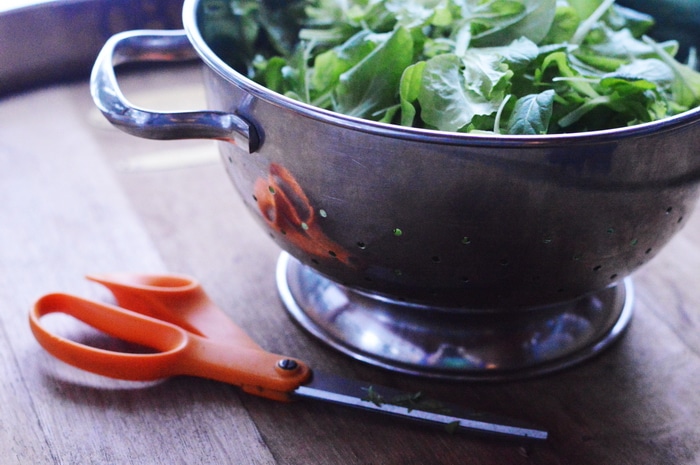
How to harvest lettuce from a cut and come again container
There are two ways to harvest container grown lettuce. You can pinch off the outside leaves, one at a time, leaving the center leaves to continue growing. This will give you larger leaves for salads. OR you can cut all the leaves one inch above the soil surface, leaving enough of the leaf surface to feed the roots through photosynthesis. Either way will allow for a second and even a third harvest from the same pot. It will take ten days to two weeks before your lettuce pot will be ready to harvest again.
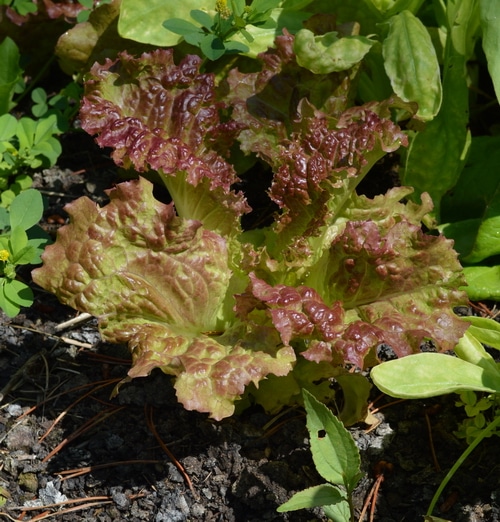
Red Sails Lettuce
My favorite heirloom lettuce for growing indoors
When growing lettuce indoors I look for certain qualities when I’m choosing lettuce varieties.
- Leaf lettuce
- Variety of colors
- Variety of textures
- Open pollinated
- Fast growth
- Early maturity
- Heirloom seed
- Inexpensive
- Can be purchased in bulk
Growing lettuce indoors is seed intensive. So you want seed that is inexpensive, can be purchased in bulk for year round growing, and offers a variety of colors, textures, and flavors for culinary interest. Open pollinated, heirloom lettuce varieties meet this criterion best.
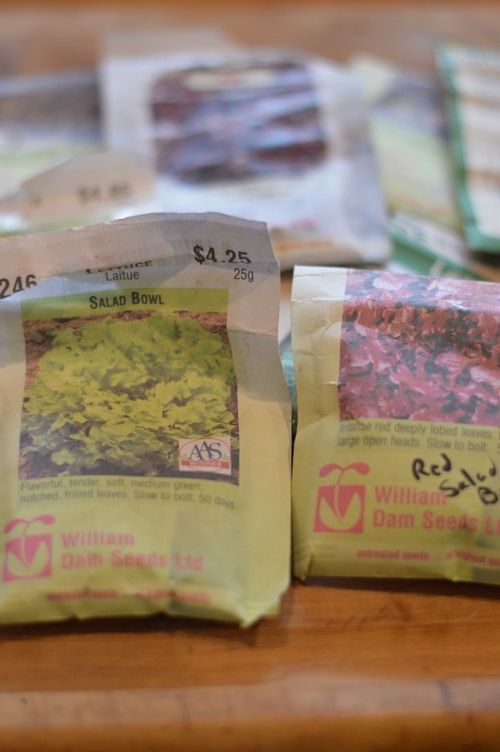
Green Lettuce that is suitable for cut-and-come-again harvests
Butter Crunch
Open pollinated, butter head type with green, soft leaves. Buttery in texture, butter crunch is a delicious lettuce that makes fast growth in a cut and come again pot. It’s also a great lettuce to grow in the garden. Slow to bolt, it can withstand a bit of heat in the garden. Loosely formed heads, it can be harvested at full size in 55 to 60 days. Pick baby leaves at 28 days. If you only grow one lettuce make it this one.
Salad Bowl
Open pollinated, loose leaf type that is both heat and bolt tolerant. Salad bowl forms rosettes with wavy, notched, oak-shaped, light-green leaves. Holds flavor and texture in hot summer. All American Selection 1952. Harvest baby leaves at 28 days. 45 days to mature heads.
Oak Leaf
Open pollinated, loose leaf type with medium-green, deeply lobed, oak-shaped leaves. Tight center and loose outer leaves on a single stalk. More compact than Salad Bowl. Very heat resistant. Also known as ‘Oakleaf’. Harvest in 28 days for baby leaves or matures in 45 days.
Red Lettuce that is suitable for cut-and-come-again harvests
Red Sails
Open pollinated, loose leaf type with deep bronze, wavy leaves and a bright green base. This open pollinated variety is slow to bolt and seldom bitter. Pick for baby leaves at 29 days. Grows well indoors under lights. Matures in 55 days. All America Selection in 1985. Heat, tip burn and bolting tolerant.
Red Oak Leaf
Open pollinated, loose leaf type with tight rosettes of deeply-lobed, oak-leaf-shaped leaves that mature to deep burgundy. Harvest at 28 days for baby greens. Red oak leaf is resistant to downy mildew and white mold. Heat and tip burn tolerant.
Ruby
Open pollinated, loose leaf type with dark-red, crinkled leaves. Specially bred for baby leaf market. Harvest baby leaves in just 28 days.
Lolla Rosa
Open pollinated, frilly leaf lettuce that forms a compact mound of deeply curled leaves. Harvest baby greens in 28 days or matures in 45 days.
Red Salad Bowl
Open pollinated, loose leaf type with deep-burgundy-red over light-green, oak shaped leaves that are slow to become bitter. Fast-growing, heat-tolerant, and relatively slow to bolt. Pick for baby leaves at 28 days. Grows well indoors under lights. All America Selection 1985. Heat, tip burn and bolting tolerant.
Outredgeous
Open pollinated romaine lettuce for baby leaf or full head harvest. Mature heads are tall but somewhat loose and maintain red color even under low-light conditions. Harvest baby greens in 28 days or mature heads in 57 days.
Merlot
Open pollinated, loose leaf type with shiny, deep burgundy, savoy leaves. It is considered the darkest red lettuce with high anthocyanin content. It is slow to bolt with a high resistance to downy mildew. Strong cold tolerance, for fall growing. Harvest for baby leaves at 28 days or grow for 55 days to maturity.
Blushed lettuce that is suitable for cut-and-come-again harvests
Merveille des Quatre Saisons
Open-pollinated, French, heirloom butterhead type, with loosely cupped pale leaves tinged with shades of ruby, rose-pink and bronze surround pale yellow-green heart. Also known as ‘Continuity’. Harvest at the baby leaf stage in 28 days or matures in 50 days.
Prizehead
Open pollinated, looseleaf type with crinkly outer leaves tinged with red. This is best grown under lights in a controlled environment. It tends to bolt when exposed to high temperatures.
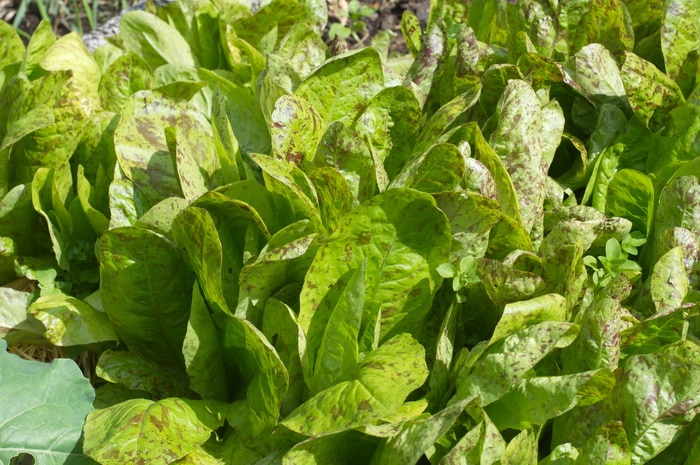
Speckled Lettuce that is suitable for cut-and come again harvests
Flashy Butter Gem
Romaine lettuce with magenta flecks over a light green leaf. High yielding introduction Frank Morton of Shoulder to Shoulder farm. Open pollinated.
Forellenschluss
Open pollinated, Austrian heirloom with speckled, romaine leaves. Harvest the baby leaves in 28 days or reaches maturity in 60 days. Also called “Freckles”, “Trout back”, and “Flashy” in seed catalogs.
Speckles
Open pollinated butterhead type that is an Amish heirloom. Small, firm heads with apple-green outer leaves splashed with maroon flecks and soft, creamy-yellow, blanched inner leaves. Harvest baby leaves in 28 days. Matures in 50 days.
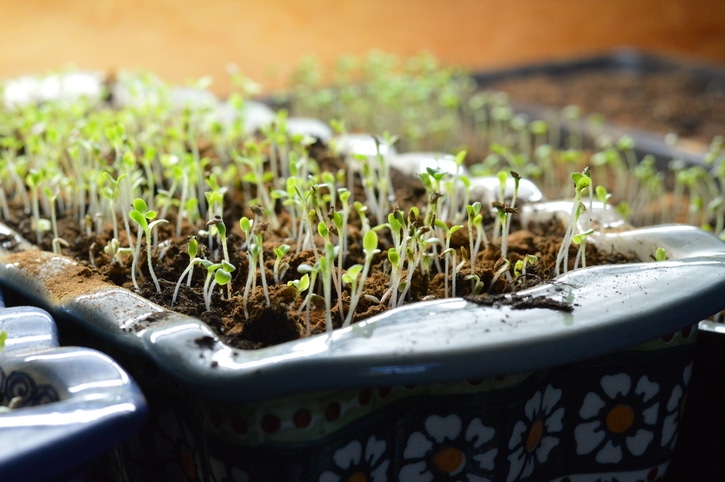
Dealing with Pests when growing lettuce indoors
Pests like spider mites, fungal gnats, and white flies are the main pests you’ll be dealing with when you grow lettuce indoors, under lights.
These pests are attracted to the cool, dampness of the plants. Flying pests can be vacuumed up as you notice them to interrupt their life cycle. Use sticky traps around your plants to clean up the area. Cinnamon can act as a deterrent by masking the scent of the plants and confusing their insect pheromones. Diatomaceous earth sprinkled on the soil surface will act as a strong deterrent.
Damping off disease and other fungal diseases
Water only when necessary. Use cinnamon to prevent fungal diseases. Add a fan for air circulation to keep the soil from holding water which can encourage damping off, molds, and other fungal issues.
How to keep your salad bowl full by growing lettuce indoors
Plant a pot of lettuce seed once a week for 4 to 6 weeks. After 4 weeks, you’ll be harvesting one pot of lettuce weekly for 12 weeks. It will take your cut lettuce about two weeks to grow large enough to cut again. Your third or fourth harvest from your pot, you’ll want to renovate the planter with fresh soil and fertility and replant.
New to growing baby green indoors?
Check out the Fill Your Salad Bowl workshop and learn how to use 3 different growing methods, at home, so you can fill your salad bowl with super food, nutrient dense, greens every single day. These are greens you can use in your salad bowl, greens you can add to soups, stews, and pasta dishes, and even greens you can use in a stir fry.
In this mini workshop you will learn how to fill a salad bowl every day with food you grow yourself.
- Even if you don’t have any land.
- Even if there is 3 feet of snow covering your garden
- Even if you’ve killed house plants in the past.
- Even if you think you have a black thumb.
Have a look at what’s covered in this workshop and see if its a good fit for you, by clicking/tapping the blue button below.


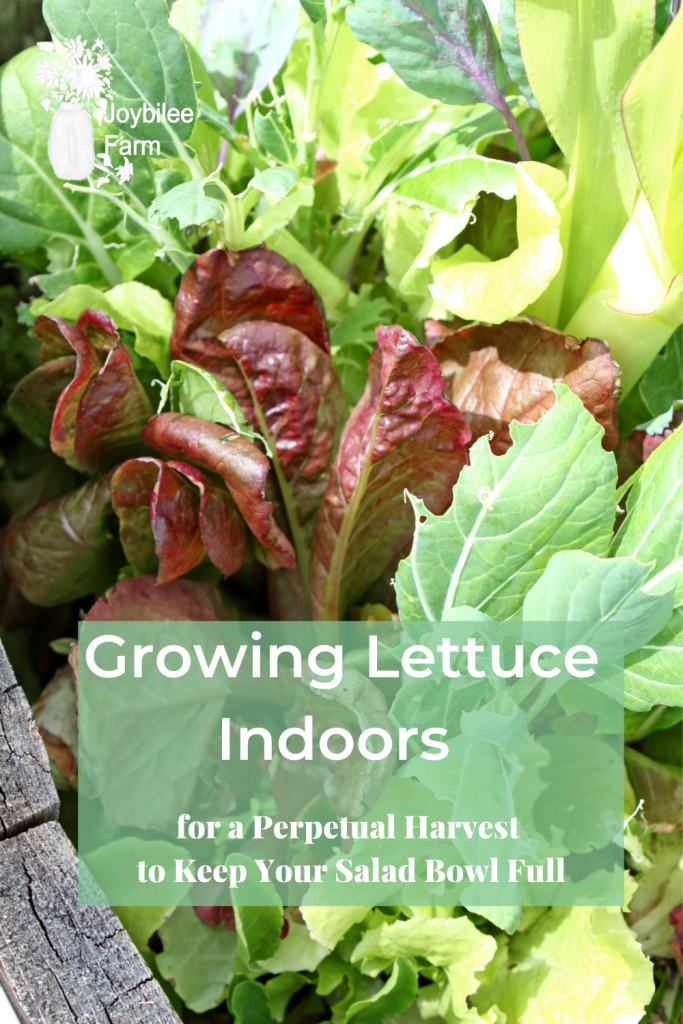





I’ll send it to your directly.
It prevents damping off, molds, and fungus from growing in the damp soil.
Is the purpose of the hydrogen peroxide in the potting mix hydration step to kill off fungus gnats and their larva? Any other benefits from the H2O2? Thanks.
I have been trying to sign up for the garden tips and have not received anything. Thank you
dkshipp57@gmail.com
When growing lettuces in mny unheated hoop house during the winter months i found white flies had taken over my lettuces. Afrd er years of playinbg around i discovered that red tinged lettucess like merlot and red sails, to name a few did nkot seem to draw the insects so much.